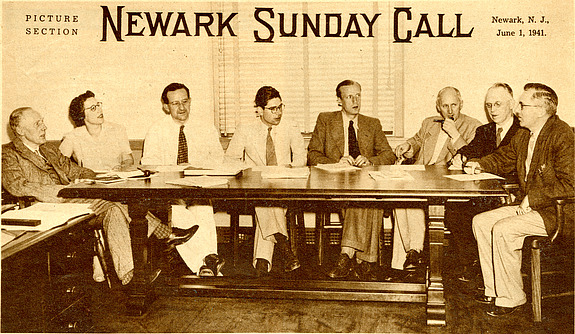The League of Nations at IAS

On September 29, 1940, a small band of League of Nations employees and their families arrived at the Institute for Advanced Study, where they would base the civilian operations of the League’s Economic and Financial Organization for the next five years. Led by Scotsman Alexander Loveday, the cosmopolitan group with members from Ireland, Sweden, Estonia, Canada, the Netherlands, Belgium, Czechoslovakia, Romania, Switzerland, France, and New Zealand comprised some of the leading experts in economics, finance, and demography. But why were they in Princeton?
The answer to this question lies in a mix of the personal, the political, and the circumstantial. At the time, the circumstances seemed the most important and were certainly the most dramatic factor. In 1940, the Economic and Financial Organization was the largest and most important agency of the League of Nations, the international body that preceded the United Nations. Its secretariat, a civil-servant section of economists and statisticians from around the world, came to the United States to escape a Nazi-occupied Europe that left the League isolated and at risk of Axis domination. When Loveday, the Director of the agency, put out his first call for help to the Institute in early May 1940, what remained of democratic Europe was on the brink of collapse.
By the time Loveday and his colleagues arrived at the Institute, Belgium and France had fallen to the Axis powers, British forces had been pushed back across the English Channel, and the only route out of Europe was across a hostile Spain and an unpredictable Portugal. (The League officials shared a fairly typical, if not fortunate, tale of flight: on their way from Geneva they survived a serious bus crash in which three members of the party were injured, then endured a three-week wait, huddled together on a shared mattress in a public room in Lisbon, before securing safe passage on board the Exeter.)
Aside from affording sanctuary, there were also constructive, political reasons why a League presence in Princeton was important. Moving the Economic and Financial secretariat to the Institute preserved the League’s invaluable expertise and made it readily accessible to the United States government, which placed economic and financial reconstruction at the heart of its plans for a new world order. Between 1940 and 1945, the number of League officials based at Princeton grew from eleven to thirty-five. They helped establish the United Nations Relief and Reconstruction Administration in 1943, drafted plans for the new monetary order agreed to at the Bretton Woods Conference in 1944, and advanced the trade liberalization that resulted in the General Agreement on Tariffs and Trade in 1947. The League group in Princeton also provided essential practical support for the creation of the United Nations, established in 1945.
None of this would have been possible without the pivotal role played by the Institute. Its intervention in the summer of 1940 was crucial, as Director Frank Aydelotte explained to the Institute Trustees, “for the League was unlikely to approach the United States, a non-Member, and the United States would hardly approach the League.” Moving the League’s secretariat to the United States touched political sensitivities that ran deep, especially in 1940, an election year in which President Roosevelt bid for a controversial third term and the nation, though divided on issues of foreign engagement, began to prepare for war.
In a series of deft moves, Aydelotte, who had served as President of his local League of Nations Association for many years, quickly put together a tripartite response to Loveday’s plea that included the Rockefeller Foundation (which helped to bankroll the move) and Princeton University, which made great play of “Wilson’s University” saving the League in its hour of need. But it was Aydelotte who undertook the lion’s share of the work, including the sensitive political task of negotiating with Secretary of State Cordell Hull to ensure that the State Department and the White House privately supported the Institute initiative. They endorsed the Director’s efforts with alacrity.
The League’s arrival in Princeton put considerable pressure on the Institute’s resources: the new dining room in Fuld Hall was given over to the League while Faculty members were asked to share offices and secretaries to work in corridors. But the sacrifices demanded of Faculty and support staff alike were seen as a central contribution to the “mobilization of the scholarly resources of the nation” and were understood as part of the nation’s “mobilization against the threat of war,” as Aydelotte described it in an October 1940 report. Much of this history remains untold, as does the Institute’s role in efforts to persuade the United States as a whole to assume global leadership during World War II. Undoubtedly, Aydelotte would be delighted at the inauguration of the new Shelby White and Leon Levy Archives Center, which will help to recover these and other forgotten histories of the Institute.